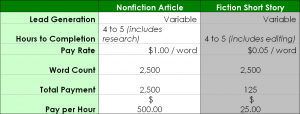Before I’ve offer you some suggestions on resources you can utilize to get published, I’d like to point out the financial aspect of writing. My only caveat to this post, is that parts of this post compare the difference between how much a short story pays versus what a nonfiction article might. Books and blogging are two entirely different matters, and I am doing everything I can to get some realistic figures and feedback in order to provide you with factual information. Regardless, the truth of the matter is that nonfiction pays more than fiction. Let’s take a look at some sample numbers for a 2,500 word article versus a science fiction short story.
The nonfiction rate came from a major magazine with a large distribution; the fiction rate is a “professional writer’s rate” advocated by the Science Fiction Writer’s Association. When you have a chance to sit down and look at all the different publishers yourself (the most common one being Writer’s Market’s paid subscription service, you’ll often see that nonfiction consistently pays more than fiction does.
What does this mean to you?
Doing a cost analysis like the one I had provided above will help you understand what your writing is worth to you. Sometimes, finding the work (aka lead generation) takes more time than actually doing the work. This is one of the reasons why it’s essential to ensure you negotiate your rights in your favor. There are publications that will accept reprints; your ability to reprint your edited and polished work is like earning free money.
Don’t forget, that there might be hidden costs to working on a project that you are not aware of. Even though we have the fortune to write in the digital age, some publishers ask for submissions by mail. This can add quite a bit of expense to you, depending upon the length of the work, because you’ll have to pay for postage, quality printing on good paper and postage tracking.
The other thing a matrix like this will point out, is how long it takes you to write. Some writers are more prolific than others and, as you can see in the above example, you do have an added incentive to write well and write quickly. Specializing in a particular genre or nonfiction area like gardening or health will inevitably speed up your process, too, but it also may limit your ability to get published in other areas. There are positives and negatives to both approaches.
Tracking Your Submissions
Whether you’re submitting one story or several, you’ll need to factor in additional time (ergo money) for “project management.” Remember, some publishers frown on simultaneous submissions while others don’t mind as much. Either way, setting your submission process up through a project management system (like Voo2Do: the Free Web-Based Task Management Tool) is a smart idea that will save you time and money in the long run. Organizing your emails, submissions, and contacts can add a layer of time to your efforts; keep that in mind whenever you’re responding to projects, too.
Sometimes, managing editors utilize email as their form of task management, but it doesn’t always work when there’s a high amount of creativity involved. In this case, suggest better tools to decrease the amount of time spent on a project. For example, if there is a lot of back and forth discussion with several writers over email, recommend a Skype conference call, live chat, or set up a Yahoo! Group to leave a trail where all contributors can track communications.
Remember, the less time it takes you to set expectations, brainstorm and manage a project, the more time it will give you to complete the project.
What are Your Experiences?
I’d like to turn it back to you now, and invite other authors to post comments on this blog post. If you have experiences you’d like to share with others please feel free to educate, inspire, and contribute. My experiences and my take might be different than what you’re going through, and I’m always happy to hear from others.
Happy scribing and Good Luck!




3 Responses to The Cost of Writing Fiction versus Nonfiction